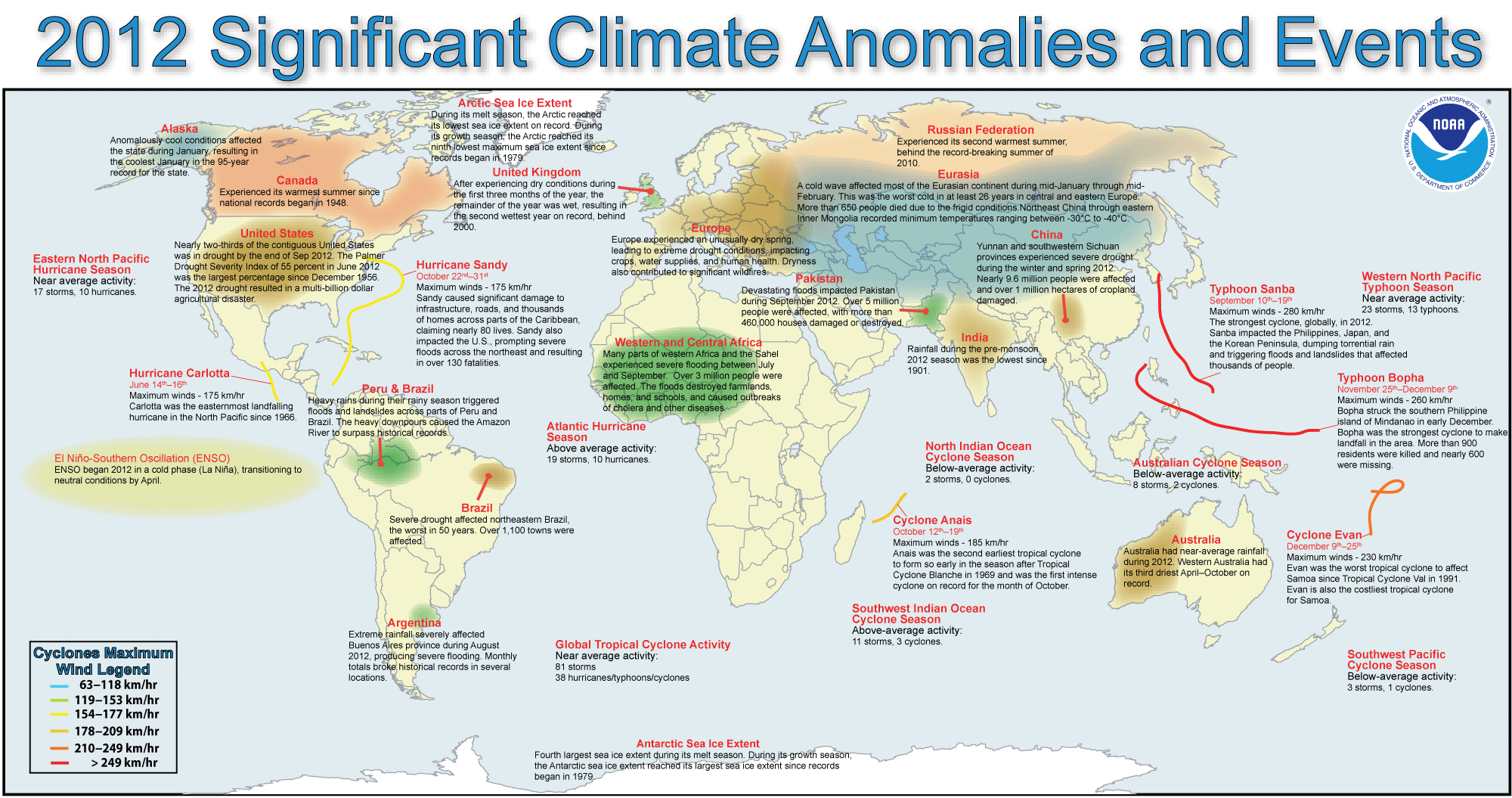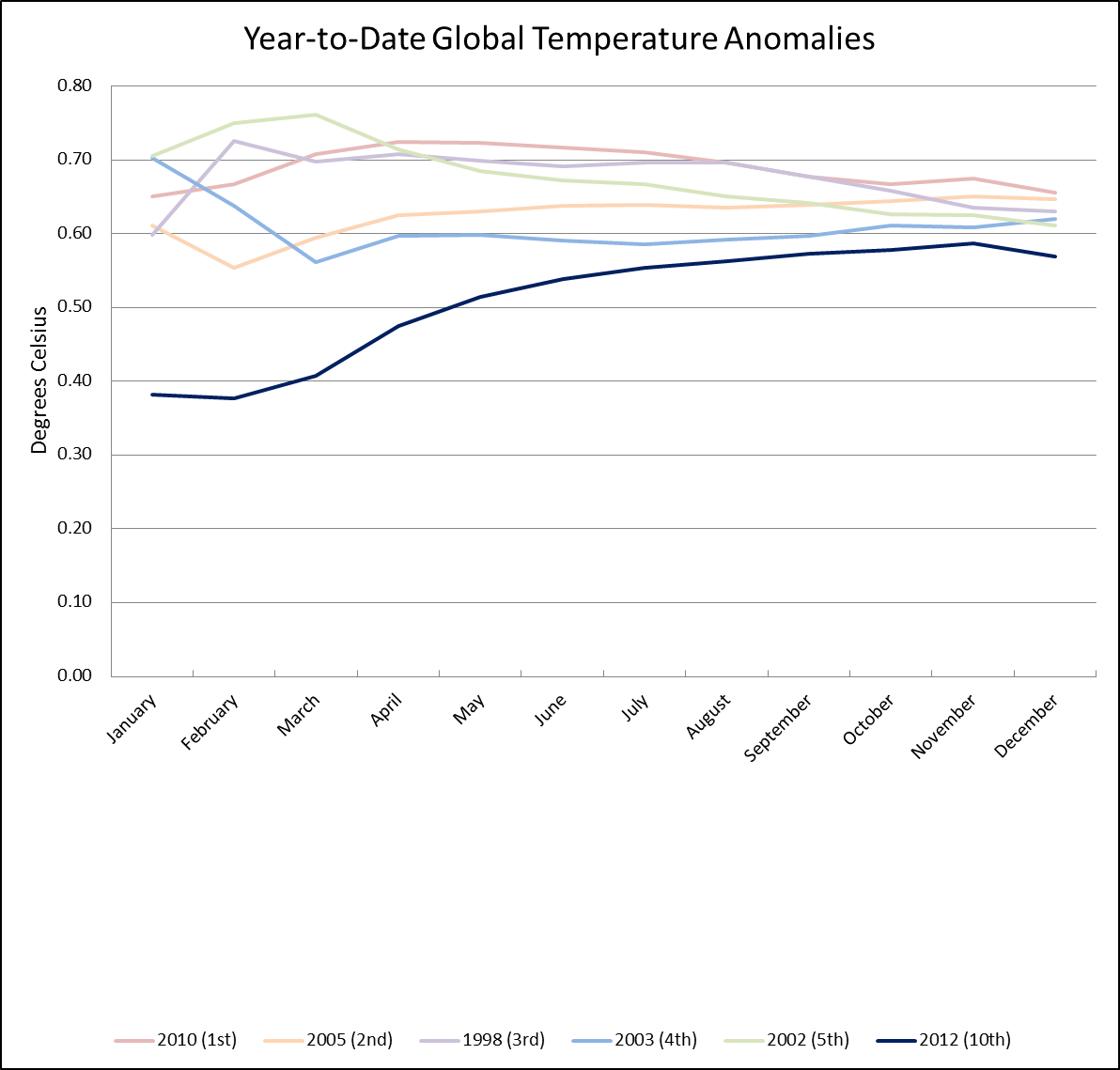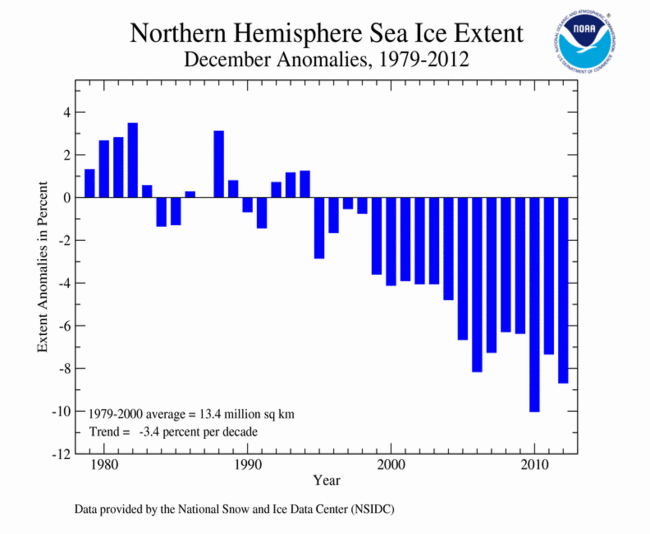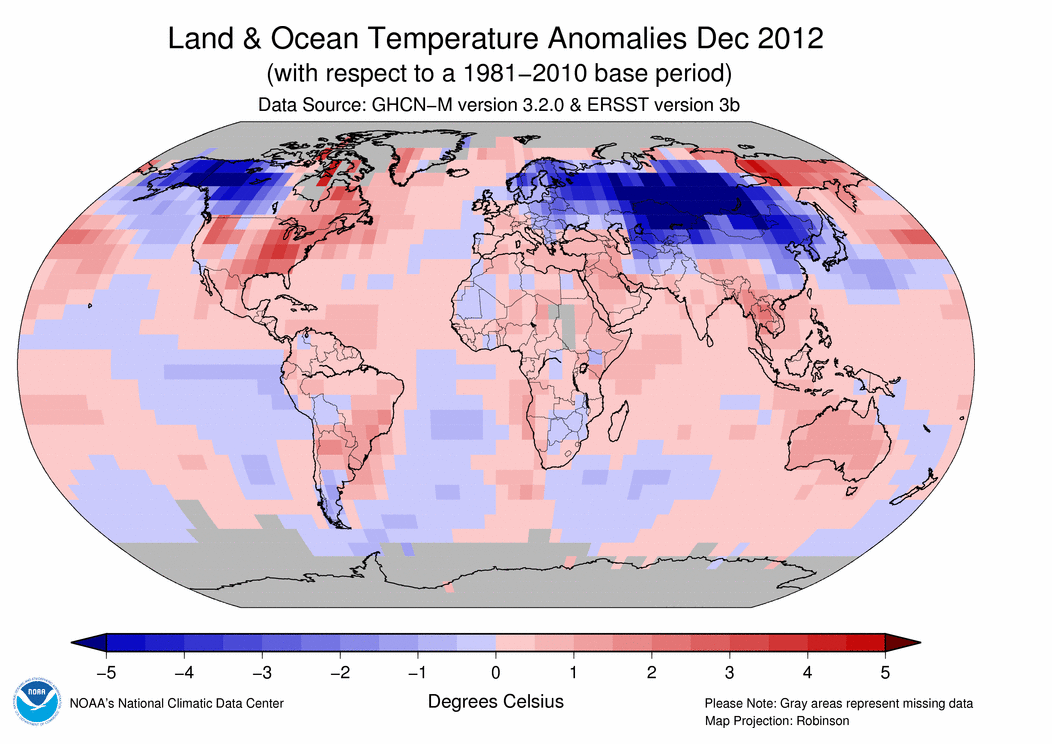2012 global temperatures 10th highest on record
2012 was also warmest "La Niña year" on record
The globally-averaged temperature for 2012 marked the 10th warmest year since record keeping began in 1880. It also marked the 36th consecutive year with a global temperature above the 20th century average. The last below-average annual temperature was 1976. Including 2012, all 12 years to date in the 21st century (2001–2012) rank among the 14 warmest in the 133-year period of record. Only one year during the 20st century—1998—was warmer than 2012.
Most areas of the world experienced higher-than-average annual temperatures, including most of North and South America, most of Europe and Africa, and western, southern, and far northeastern Asia. Meanwhile, most of Alaska, far western Canada, central Asia, parts of the eastern and equatorial Pacific, southern Atlantic, and parts of the Southern Ocean were notably cooler than average. Additionally, the Arctic experienced a record-breaking ice melt season while the Antarctic ice extent was above average.
2012 Global temperature highlights
- 2012 was the 10th warmest year since records began in 1880. The globally-averaged annual combined land and ocean surface temperature was 0.57°C (1.03°F) above the 20th century average of 13.9°C (57.0°F). The margin of error is ± 0.08°C (0.14°F).
- 2012 also marked the 36th consecutive year with a global temperature above the 20th century average. The last colder-than-average year was 1976.
- Record to near-record warm land surface temperatures in the Northern Hemisphere from April to September and overall warmer-than-average ocean surface temperatures made the first 11 months of the year the eighth warmest on record. However, extreme cold across much of the Northern Hemisphere land during December helped lower the year-to-date temperature departure from average by 0.02°C (0.04°F) compared with the previous month.
- The global annual temperature has increased at an average rate of 0.06°C (0.11°F) per decade sine 1880 and at an average rate of 0.16°C (0.28°F) per decade since 1970.
- The 2012 worldwide land surface temperature was 0.90°C (1.62°F) above the 20th century average, making it the seventh warmest such period on record. The margin of error is ± 0.18°C (0.32°F).
- Some national highlights are included below:
- The contiguous United States had its warmest year since national records began in 1895, surpassing the previous record set in 1998 by 0.6°C (1.0°F).
- Austria experienced its seventh warmest year since national records began in 1767, at 1.0°C (1.8°F) above the long-term average.
- With the first half of 2012 cooler than average and the second half warmer than average, on balance the annual 2012 temperature across Australia was 0.06°C (0.11°F) above the 1961–1990 average. Only the year 2011 has been below average in the past decade.
- The 2012 temperature across the United Kingdom was 0.1°C (0.2°F) below the 1981–2010 average. This is in part attributed to the UK's coolest summer since 1998 and coolest autumn since 1993.
- Norway had its 45th warmest year since record began in 1900, at 0.4°C (0.7°F) above average.
2012 Precipitation highlights
- Following the two wettest years on record (2010 and 2011), 2012 had near average precipitation on balance across the globe. However, precipitation varied greatly in some regions.
- Major drought gripped important agricultural regions across the world during summer 2012. These regions included eastern Russia, Ukraine, Kazakhstan, and central North America.
- By the end of 2012, northeastern Brazil was experiencing its worst drought in decades.
- The rainy season was wetter than normal across western and central Africa. Flooding affected more than three million people across 15 countries from July to October.
- The United Kingdom had its second wettest year since records began in 1910, falling just 7.3 mm (0.29 inches) shy of the record wetness of 2000. Particularly notable, record dryness during March turned to record wetness in April.
- Finland was wetter than average for 2012, with many stations observing their wettest year in the past half century. The capital city of Helsinki reported its second wettest year, behind 1944, since records began in the early 19th century.
2012 snow and polar ice highlights
- For all of 2012, Arctic sea ice extent was below average.
- On March 18th, Arctic sea ice reached its annual maximum extent at 5.88 million square miles (15.24 million square km)—0.24 million square miles (0.61 million square km) below average—which began the annual melt season.
- The annual Arctic sea ice melting ended on September 16th, when the Arctic sea ice extent dropped to 1.32 million square miles (3.41 million square km), the lowest value ever recorded. The annual minimum extent was 49 percent below average and 0.29 million square miles (0.76 million square km) below the previous smallest extent which occurred in September 2007.
- Between March 18th and September 16th, 4.57 million square miles (11.83 million square km) of ice melted—the largest ice loss of any melt season on record. Arctic sea ice during September has been lost at an average rate of 13.0 percent per decade.
- Antarctic sea ice extent was above average for most of 2012. Sea ice in the Southern Hemisphere peaked on September 26th, reaching its annual maximum extent, at 7.51 million square miles (19.44 million square km). This was the largest Antarctic sea ice extent on record, surpassing the previous record of 7.47 million square miles (19.36 million square km) which occurred in September 2006. Antarctic sea ice during September has increased at an average rate of 0.9 percent per decade.
- Winter (December 2011–February 2012) snow cover extent for the Northern Hemisphere was 228,000 square miles (590,000 square km) above average, making it the 14thlargest seasonal snow cover extent on record. North American snow cover was below average during the season, or fourth smallest winter extent on record, while Eurasian snow cover ranked as its fourth largest on record. Spring snow cover extent for the Northern Hemisphere was much below average and ranked as the sixth smallest on record. Both North America and Eurasia had below-average spring snow cover.
- The Northern Hemisphere snow cover extent in December 2012 was the largest on record at 1.2 million square miles (3.0 million square km) above average and (0.08 million square miles (0.2 million square km) above the previous record from 1985. Both North America (13th largest) and Eurasia (second largest) had above-average December snow cover.
- Winter Northern Hemisphere snow cover has expended at an approximate rate of 0.1 percent per decade, while spring Northern Hemisphere snow cover has shrunk at an approximate rate of 2.2 percent per decade.
Global temperature highlights: December
- The combined average temperature over global land and ocean surfaces for December was the 18th highest on record for December at 12.61°C (54.74°F), or 0.41°C (0.74°F), above the 20th century average. The margin of error is ±0.09°C (0.16°F).
- The global land temperature was 0.21°C (0.38°F) above the 20th century average of 3.7°C (38.7°F), the 49th warmest December on record and coolest December since 1986.
- There was stark contrast between the Northern and Southern Hemisphere land areas during December. Colder-than-average temperatures engulfed most of Eurasia and Alaska, making this the 64thcoolest (70th warmest) December for the Northern Hemisphere land area on record and the coolest since 1984. Meanwhile, the Southern Hemisphere observed record warm temperatures over land during the month. The land mass in the Southern Hemisphere is much smaller than that of the Northern Hemisphere.
- For the ocean, the December global sea surface temperature was 0.47°C (0.85°F) above the 20th century average of 15.7°C (60.4°F), the sixth warmest for December on record.






@口@///
ReplyDeletesignificant climate change........
ReplyDeletethanks for sharing~
ReplyDelete